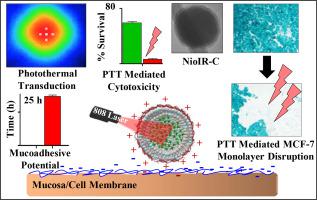Journal of Photochemistry and Photobiology B: Biology ( IF 3.9 ) Pub Date : 2020-05-20 , DOI: 10.1016/j.jphotobiol.2020.111901 Anil Jogdand 1 , Syed Baseeruddin Alvi 1 , P S Rajalakshmi 1 , Aravind Kumar Rengan 1

|
Breast cancer is one of the leading causes of mortality in women, worldwide. The average survival rate of patients suffering from advanced breast cancer is about 27% for five years. Photothermal therapy employing biodegradable nanoparticle are extensively researched for enhanced anticancer therapy in breast cancer treatment. In the current study, we report a chitosan based mucoadherant and biodegradable niosome nanoparticle entrapping near infrared (NIR) dye (IR 806) for the treatment of breast cancer. Niosome entrapping IR 806 (NioIR) showed encapsulation efficacy of about 56 ± 2%. The prepared nanoparticles (NioIR) were further coated with chitosan (NioIR-C) to impart mucoadhesive property to the nanosystem. NioIR-C showed minimal degradation following NIR laser irradiation, thus enhancing its photothermal stability. They also exhibited efficient photothermal transduction, when compared with IR 806 dye. NioIR-C were biocompatible when treated with normal cell lines (NIH 3T3 and L929) and showed cytotoxicity towards breast cancer cell lines (MCF-7 and MDA-MB 231). When triggered with NIR laser, NioIR-C showed photothermal cell death (approximately 93%). The presence of chitosan coating on NioIR led to mucoadherence potential that further enhances the therapeutic effect on breast cancer cells when compared with IR 806 dye and NioIR. Thus NioIR-C can be a promising nanosystem for effective treatment of breast cancer using photothermal therapy.
中文翻译:

基于NIR染料的粘膜粘附纳米系统,用于乳腺癌细胞的光热疗法。
乳腺癌是全世界女性死亡的主要原因之一。晚期乳腺癌患者五年的平均存活率约为27%。广泛研究了采用可生物降解纳米粒子的光热疗法,以增强乳腺癌治疗中的抗癌治疗。在当前的研究中,我们报道了一种基于壳聚糖的黏膜粘附剂和可生物降解的纳米微粒,包埋了近红外(NIR)染料(IR 806),用于治疗乳腺癌。包裹脂质体的IR 806(NioIR)显示出约56±2%的封装效率。将制备的纳米颗粒(NioIR)进一步用壳聚糖(NioIR-C)涂覆,以赋予纳米系统粘膜粘附性能。NioIR-C在NIR激光照射后表现出最小的降解,因此增强了其光热稳定性。与IR 806染料相比,它们还表现出有效的光热传导。NioIR-C在用正常细胞系(NIH 3T3和L929)处理时具有生物相容性,并显示出对乳腺癌细胞系(MCF-7和MDA-MB 231)的细胞毒性。当用NIR激光触发时,NioIR-C显示出光热细胞死亡(约93%)。与IR 806染料和NioIR相比,NioIR上壳聚糖涂层的存在导致粘膜粘附潜能,进一步增强了对乳腺癌细胞的治疗效果。因此,NioIR-C可能是使用光热疗法有效治疗乳腺癌的有前途的纳米系统。当用NIR激光触发时,NioIR-C显示出光热细胞死亡(约93%)。与IR 806染料和NioIR相比,NioIR上壳聚糖涂层的存在导致粘膜粘附潜力,进一步增强了对乳腺癌细胞的治疗效果。因此,NioIR-C可能是使用光热疗法有效治疗乳腺癌的有前途的纳米系统。当用NIR激光触发时,NioIR-C显示出光热细胞死亡(约93%)。与IR 806染料和NioIR相比,NioIR上壳聚糖涂层的存在导致粘膜粘附潜力,进一步增强了对乳腺癌细胞的治疗效果。因此,NioIR-C可能是使用光热疗法有效治疗乳腺癌的有前途的纳米系统。











































 京公网安备 11010802027423号
京公网安备 11010802027423号